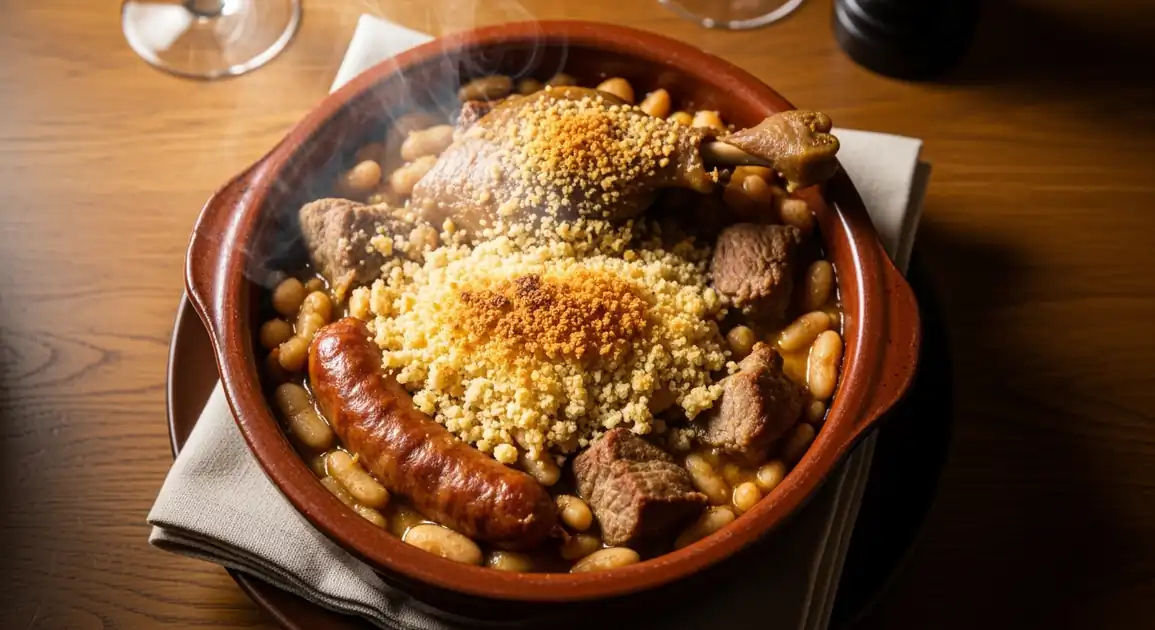Cassoulet
Cassoulet

Description
Cassoulet is a celebrated regional dish from Languedoc in Southwestern France, but its popularity means it can be found in traditional restaurants and bistros across the country, especially during colder months. It's considered a hearty, classic main course.
Dietary Information
Serving information
Serving style
Served very hot as a main course, usually in the individual or larger earthenware dish (cassole) it was baked in.
Quick facts
Served during standard lunch (12 PM - 2 PM) and dinner (7 PM - 10 PM) hours in restaurants and bistros.
Safety Tips
What to Look For
-
Served piping hot, ideally bubbling
Ensures the dish has been heated thoroughly to safe temperatures and is freshly served.
-
Reputable restaurant with good hygiene standards
Choose established restaurants known for quality French cuisine, reducing general food safety concerns.
-
Well-cooked, tender meats and creamy beans
Indicates proper preparation. Undercooked beans or tough meat suggest rushed cooking.
-
Dish smells fresh and savory
Trust your senses; the aroma should be rich and appealing, not sour or off.
What to avoid
-
Lukewarm or cold cassoulet
Incorrect serving temperature is a food safety risk and diminishes the quality of the dish.
-
Restaurants with poor cleanliness reviews or visible hygiene issues
General hygiene is crucial for food safety.
-
Undercooked beans (hard) or questionable meat quality
Signifies improper preparation which can impact safety and taste.
-
Cassoulet that seems overly watery or soupy
While not strictly a safety issue, it indicates a poorly made version lacking the proper richness and texture.
Price information
Price range
Budget tips
- Cassoulet is generally a mid-range to expensive dish due to ingredients and long cooking time.
- Look for it as a 'plat du jour' (dish of the day) in bistros for potentially better value.
- Prices are higher in major cities and tourist areas.
Value indicators
- Generous portion size.
- Visible quality ingredients (e.g., whole duck leg confit).
- Rich, complex flavor indicating slow cooking.
- Served in a traditional earthenware 'cassole'.
Where to Find This Dish
Southwestern France (Languedoc)
The origin region (Toulouse, Carcassonne, Castelnaudary) offers the most authentic experiences.
Regional towns, Local Auberges
Lunch, Dinner
Traditional Bistros Nationwide
Classic bistros across France often feature it, especially seasonally.
City centers, Neighborhood bistros
Lunch, Dinner
Specialty Regional Restaurants
Restaurants focusing on 'cuisine du terroir' or specifically Southwestern food.
Major cities
Dinner
Vendor Tips
- Look for mentions of 'fait maison' (homemade).
- Check if the menu specifies the style (Toulouse, Castelnaudary).
- Pair with a recommended regional red wine for the full experience.
How to Order
Regional Variations
-
Cassoulet de Toulouse
(Cassoulet Toulousain)
Generally includes Toulouse sausage, duck confit, pork (shoulder or belly), and white beans, often topped with breadcrumbs baked to a crust.
-
Cassoulet de Castelnaudary
(Cassoulet de Castelnaudary)
Often considered the most 'pure', featuring duck or goose confit, pork (various cuts like knuckle, shoulder, rind), sausage, and white beans. May not always have a pronounced crust.
-
Cassoulet de Carcassonne
(Cassoulet de Carcassonne)
Similar to Castelnaudary but traditionally includes mutton (lamb shoulder) and sometimes partridge in addition to the duck/goose confit and pork.
Cultural context
History
Cassoulet's origins are rooted in the Languedoc region during the medieval period. Legend attributes its creation to the town of Castelnaudary during a siege in the Hundred Years' War, though this is likely folklore. It evolved from peasant fare, utilizing preserved meats and beans. The three towns of Castelnaudary, Carcassonne, and Toulouse each claim paternity and have distinct traditional recipes, solidifying cassoulet as a cornerstone of French regional gastronomy.
Local significance
A symbol of French regional cuisine and culinary heritage, particularly from Languedoc. Represents conviviality, generosity, and rustic gastronomy.
Eating customs
- Eaten hot as a main course.
- Best enjoyed slowly, savoring the rich flavors.
- Often accompanied by a simple green salad and crusty bread.